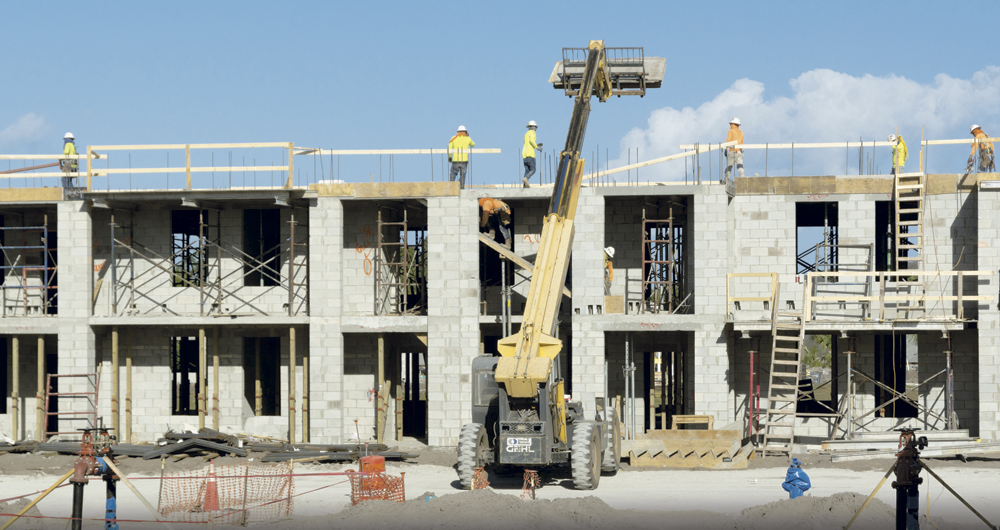NAVIGATING FLORIDA BUILDERS RISK
How to deal with challenging situations in a complex market
By Dawn Gordon, CPCU
The construction market in Florida has been robust in recent years and continues to grow. Despite the devastating impact of the 2008 recession, Florida’s construction industry has rebounded and presents new opportunities for growth alongside a steady rise in population. According to the U.S. Census Bureau, based on percentage growth, the state has consistently been one of the top 10 fastest growing states in the country for the past six years running. Florida has also had the second largest overall population increase of any state for the past five years straight, based on numeric growth, even though countrywide population estimates indicate an overall growth decline. This population influx brings new opportunities for contractors, but they face exposures that require proper coverage.
Historically, finding the coverage necessary hasn’t been a concern. However, hurricane losses over the past few years have made a significant impact on today’s market. Hurricanes Irma, Matthew, and Michael specifically have impacted carriers’ willingness to provide coverage to Florida builders risk insureds. Inland construction, high-rises, and other joisted masonry projects present less of a problem. However, there are significant challenges with frame construction on or near the water because waterfront properties are more susceptible to hurricanes and flooding, and the market has taken multiple financial losses.
Market challenges
There are now fewer market players, and placing coverage has become more complex. The challenge lies not only in builders risk placement but also obtaining the additional coverages that go along with coastal construction, such as wind and flood. This isn’t solely due to less participation from carriers; it’s also a coverage issue. Florida retailers may be able to find builders risk, but they are having issues with wind and flood. The closer the risk is to the coast, the less likely admitted markets are to provide wind and/or flood coverage.
Carriers are trying to spread their risk and find a balance. Unfortunately, … extreme losses occurred in a relatively short span of time (and) the market overall has been left with little time to recover. As a result, insurance companies are now offering coverage limits at a fraction of what they would have in previous years.
These placement challenges are not exclusively due to Florida’s weather catastrophes. The insurance market is extremely interconnected. Natural disasters that occur in any geographic location have consequences impacting the entire country, especially when it comes to the insurance marketplace.
In addition to hurricanes, fire losses across the country within the last two to three years have made placing coverage much more restrictive, particularly for new frame construction. For example, national carriers took a huge hit in 2018 because of wildfire losses on the west coast; it marked the most destructive fire season for California ever recorded.
Additionally, the flood impacts of 2017’s Hurricane Harvey took a toll. The flooding didn’t affect Florida directly but did cause a huge financial loss for insureds in Texas and Louisiana, Harvey being one of the top two most costly hurricanes on record (damages at $125 billion). This has carried over to other segments of the market.
Carriers are trying to spread their risk and find a balance. Unfortunately, since all of these extreme losses occurred in a relatively short span of time, the market overall has been left with little time to recover. As a result, insurance companies are now offering coverage limits at a fraction of what they would have in previous years.
Another complication: Builders risk policy extensions have become significantly harder to come by. This can be a serious pitfall, particularly for seasoned contractors, because complications with receiving extensions were generally not an issue in past years. Projects are tending to take longer, which is often due to contractors under-estimating time for completion. This becomes very problematic when the policy is reaching expiration and insureds realize they need an extension. Extensions used to be given with no questions asked, but markets have now become wary and have started denying the requests.
Available solutions
With all of this uncertainty, retail agents are finding themselves in tough situations with their builders risk clients. Fortunately, there are solutions that can help streamline the process for better chances at success. In knowing that substantially more pre-underwriting is now required, retailers will greatly benefit by using a wholesaler who specializes in construction. These wholesalers have connections to the most appropriate markets for the risk and can access many potential options. This is not only about finding competitive pricing, but also to determine how many carriers will need to be involved, since so many commercial frame policies now have to be layered.
A good wholesaler will also know how to approach the underwriters on the insured’s behalf, so the underwriter will feel comfortable with the risk. There is often a lot of creativity required, especially for the tougher risks, and a specialized wholesaler can help agents navigate the quoting process efficiently and effectively.
Wholesalers also have resources that aren’t available to retailers on their own. While finding wind and flood coverage near the Florida coast can be problematic for retailers, a specialist wholesaler will have access to markets willing to write the wind and flood.
Some can also offer reporting form policies for contractors who are undertaking multiple home-building projects, such as housing development projects (i.e., where the contractor is building multiple homes that are similar). This involves set rates, and the insured reports on its projects monthly but pays quarterly. So, they don’t have to pay up front for the projects they haven’t started yet.
Reporting forms are on a single policy but cover several projects, which can be much more cost-effective than writing projects individually; the size of the policy enables more leeway on pricing. This becomes a lot easier to manage for both the agent and the insured, vs. having an individual policy for each home.
Finally, getting as much information as possible from insureds on the project up front is essential. The following is critical information needed to effectively quote and write commercial risks: 1) construction of project—including wall and roof materials; 2) timeline for project development period; 3) site or plot plan showing relationship between buildings and structures; and 4) statement of contractor experience with similar projects.
Adding value
In addition, to help insureds avoid needing project extensions, it’s important for retailers to explain the benefits of taking a pragmatic approach to timelines, including planning for reasonable delays. Insureds need to understand that correctly estimating the time for the project at policy inception enables them to pay today’s rates for the entire project. If they need an extension when their builders risk policy period expires, they face not only the challenge of seeing if an extension will be granted but also, depending on market changes, the rate will be subject to current market conditions.
Insureds might pay more for a longer policy term, but it will save frustration down the line by not having to file for an extension and/or incur rate increases.
The Florida Chamber of Commerce projects that Florida’s population could increase to nearly 26 million by 2030; construction projects are only going to continue to increase. While the uptick in the number of Florida-specific as well as countrywide natural disasters has had a detrimental impact on the ease of placing builders risk policies in our great state, the good news is that solutions still exist.
If agents can inform insureds of the market’s current pitfalls and complications, contractors can be encouraged to and have a better understanding of the need to be as transparent as possible. Knowing this can help them try to avoid project extensions, which benefits everyone. Utilizing a specialty wholesaler will also give retail agents the best tools available to properly address the risk with carriers and find the best and most comprehensive coverage the marketplace can offer.
The author
Dawn Gordon, vice president and property broker at Brown & Riding, has been in the insurance industry for more than 25 years and has spent her entire career working in Florida. She started on the carrier side and was a property underwriter, marketing rep, underwriting director, and sales director before moving to the wholesale side. She specializes in E&S property coverage, such as real estate (condominiums, apartments, LROs, hospitality), complex shared and layered programs, builders risk, CAT perils (wind, flood, and earthquake), buydowns, stock throughputs, equipment schedules, manufacturing, warehousing, vacant properties, and tough protection classes. She has earned a CPCU and is a member of the Florida Surplus Lines Association.






